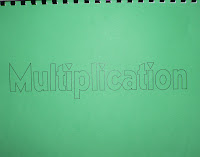Math3 started multiplication last week. Well, the curriculum assumes the 3rd grader had already learned the basics of multiplication. But our school district's curriculum doesn't coincide very well to K12's, it seems moreso in some areas than others. So we did a bit of back tracking and had a group lesson for 2-4th graders. Intro for 2 and 3rd graders and review for 4th grader. Our goal now for the next few weeks are to memorize our basic multiplication facts up to 12. If you ask our 4th grader, not knowing the facts make Math4 much more time consuming. :-)
I created a very simple multiplication set that I bound together for our week long group lessons. The children are not completed with theirs yet but the booklet went over well and I thought someone else might find the printable pages useful.
a b
a) Simple cover that I printed on card stock for the front. For the back I printed a times table to 12 that they can add stickers on as they memorize their facts. :-)
I added a colored times table also to help them realize they only really have to learn about half due to commutative property. :-)
Link for 12x12 tables: Study Skills for All Ages
b) Page 1: Initially, the children were each given a set of 18 objects and they were to divide them into equal groups. So with 4 children...I was betting that they'd divide them differently. They did. :-) Then they worked on the first page here. This allowed them to be introduced to the concepts of groups/sets, repeated addition, skip counting, what a multiplication problem looked like. I also slipped in that a the "total" of a multiplication problem was the "product".
-----------------------------------------------------------------
c d
c) They chose a multiplication problem to write in the box. I encouraged numbers greater than 2 and less than 10. Then they showed me they understood what I meant by using repeated addition, skip counting, and an array to come up with their product. Oh, yes, we had introduced an array on day one with our equal groups.
d) They enjoyed our commutative property grids. After doing some up on the dry erase I gave the children dice to roll to figure out their multiplication problem (we rolled again if we got doubles). Then they created a grid for their problem and then in the same square they drew that they understood commutative property. So they did this 4 times....a set of problem in each square.
(We added + between blue and yellow stars and = before green star.
Doesn't matter which order we mix...we still get green. :-)
----------------------------------------------------------------------------------------
e f
e) This page was just a review and a "make sure" that they understood the basics. They did this sheet on their own with their own chosen multiplication problem (using larger numbers again)
(hard to see the pencil, sorry)
f) introduced associative property, refreshed memories on friendly numbers (like 10---easy to multiply by) I used post-its and wrote a 3 factor multiplication problem on each post-it note and then they rewrote the multiplication problems adding parenthesis and/or changing the order of the factors.
---------------------------------------------------------------
And then we have pages from 0-12...each with a "story problem" to solve on the right side and space on the left to draw a sketch of the story problem. On the bottom is a little tips for multiplying by that number.
(We are working our way through all the pages through 12...we'll go back and add color and designs to the cover and pages. I playing with the idea of having them write all the multiplication problems using the factor inside of the number . For example, inside 2 we'd right 2x0=0, 2x1=2, 2x3=6, etc)
Interesting observation...my 4th grader who did have all his multiplication facts memorized last year and doesn't now and was reviewing with us was very excited about some of the activities we did. He told me "they never did this when I learned multiplication." Sad. It was basic activities that I thought most people did to help children understand multiplication. But you know what...I wouldn't have been surprised if his teacher didn't teach the basis of multiplication so much...or if they did it was just to touch on it saying it was repeated addition. Most likely they spent their time working on memorizing facts. I'm a firm believer that before they start "memorizing facts" they should understand the why of a concept first. (Each teacher is different. We weren't impressed with last year's teacher for A. His attitude toward learning went downhill this year amongst other things.)
I had hoped to do math notebooking this year but that good intention fell by the wayside when my two oldest got accepted to MVCA and I was trying to do math using K12's approach. 3rd/4th grade math instruction is mostly online. I like the sequence but I don't care for the online instruction. The teacher's guide really doesn't do all that well with explaining what they are explaining to the kids so if they don't get it...I'm lost. They teach math a little differently than I learned. So now I've been going ahead in their lessons to get a good idea of what they are doing and we do the math mostly offline with 1:1 or group instruction. Much more timely this way! So, in came the idea to make a multiplication book. This is something they'll be able to go to for a reference. I have begun to make something similar for A.'s fraction unit. We started a group lesson on fractions today also with 2-4th graders. Review for 3rd-4th grader and intro to 2nd graders (both love math and like these "extra" lessons). I'll go as in depth as Aaron's lessons go. I'll share the fraction booklet when it's completed.


















No comments:
Post a Comment